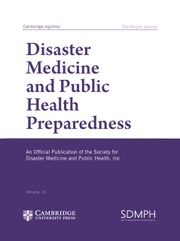No CrossRef data available.
Article contents
Factor Analysis of Disaster and Evacuation Awareness in Japan: Understanding Social Vulnerabilities through Multiple Statistical Approaches
Published online by Cambridge University Press: 26 September 2025
Abstract
This study examined how social vulnerability factors—such as caregiving, economic instability, and nonregular employment—affect disaster preparedness and awareness, with a focus on nonlinear associations with evacuation and disaster awareness.
Cross-sectional analysis of a nationally representative survey
Data came from the 2023 Japan COVID-19 and Society Internet Survey (JACSIS), including 28,481 participants. Factor analysis identified two preparedness domains: evacuation awareness and disaster preparedness awareness. Generalized linear models (GLM) assessed associations between awareness scores and sociodemographic and health factors. Sensitivity analysis used a random forest model, and logistic regression examined predictors of low awareness.
Two factors explained 76% of variance in preparedness behaviors. GLM showed that older age (Estimate = 10.99, P < .001), larger household size (Estimate = 4.34, P < .001), high income (Estimate = 0.08, P < .001), and community attachment (Estimate = 0.09, P < .001) were positively related to evacuation awareness, while nonregular employment (Estimate = -0.03, P = .01) and public assistance (Estimate = -0.05, P < .001) were negatively associated. Logistic regression confirmed that reliance on public assistance (OR = 1.54, 95% CI [1.26, 1.87]) and nonregular employment increased odds of low preparedness.
Social vulnerability factors are linked to lower disaster awareness, identifying a subgroup at higher risk. Preparedness policies should account for demographic and economic disparities, emphasizing tailored, community-based strategies to improve resilience among vulnerable populations.
Keywords
Information
- Type
- Original Research
- Information
- Copyright
- © The Author(s), 2025. Published by Cambridge University Press on behalf of Society for Disaster Medicine and Public Health, Inc

